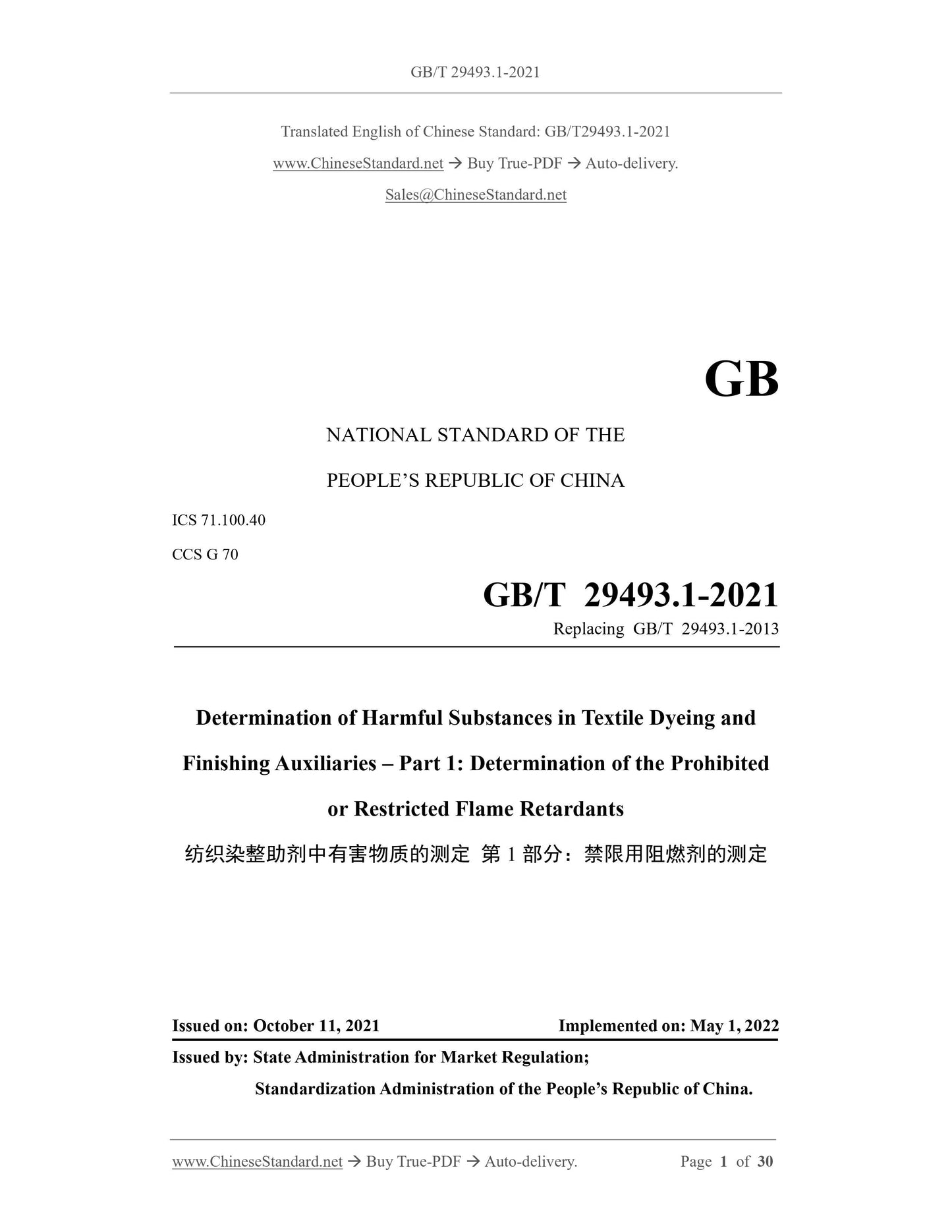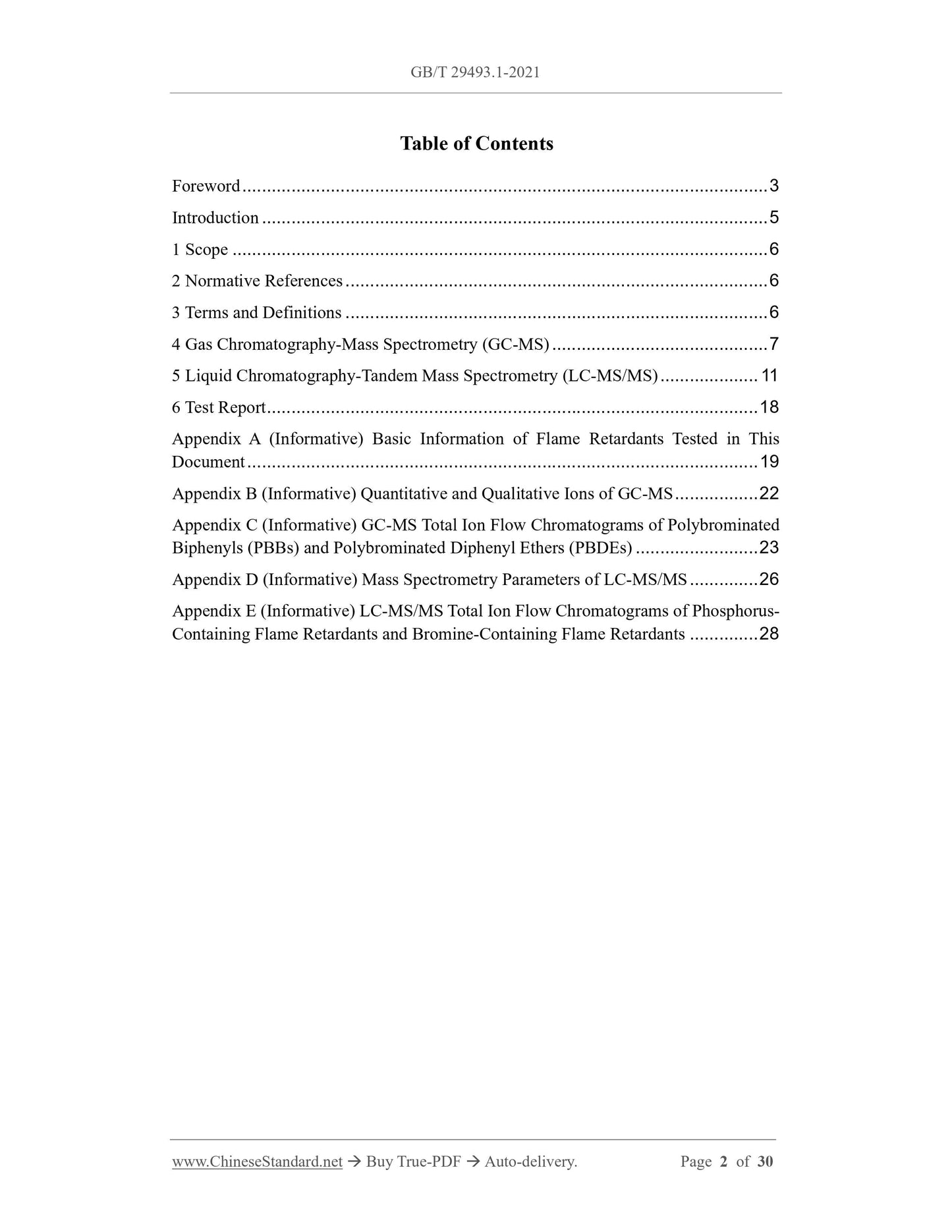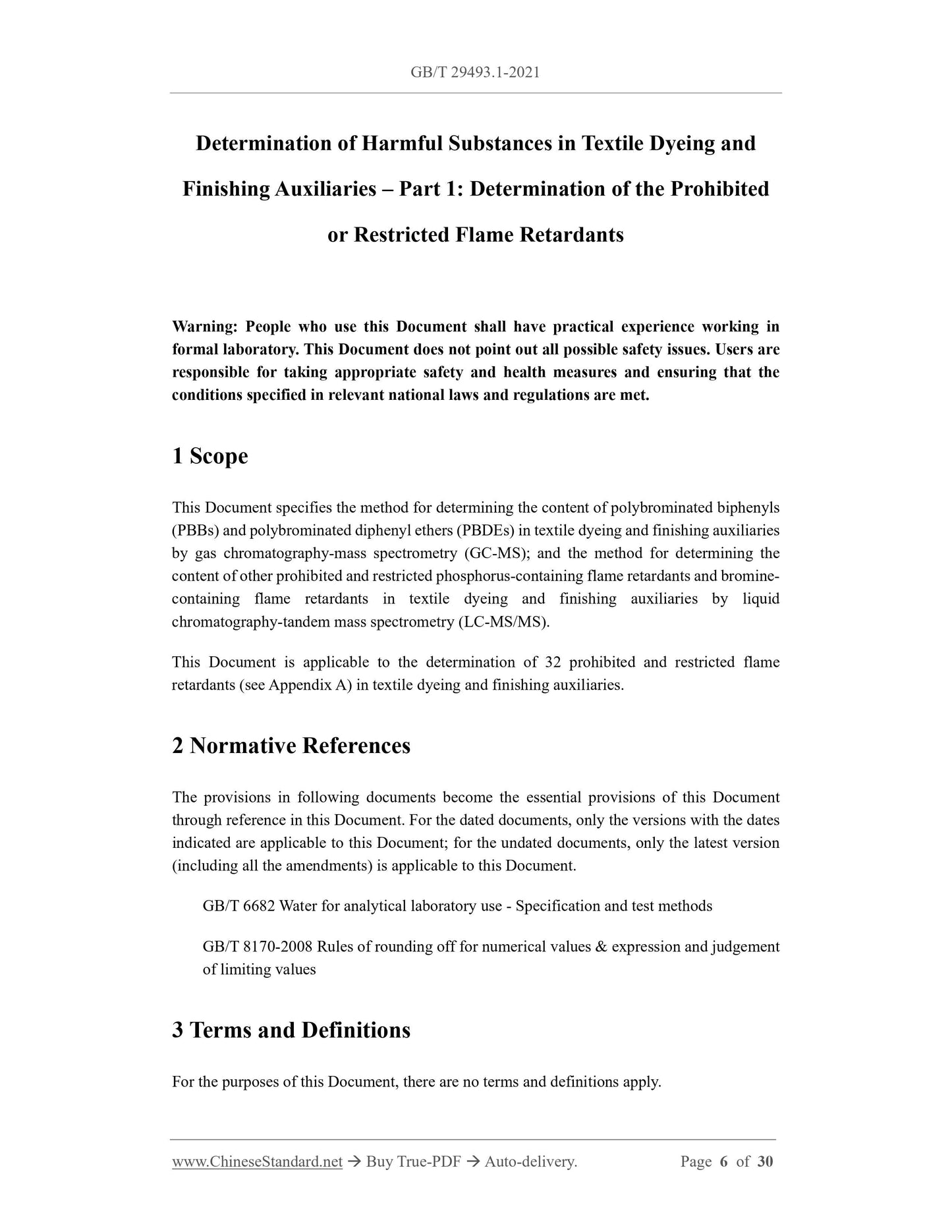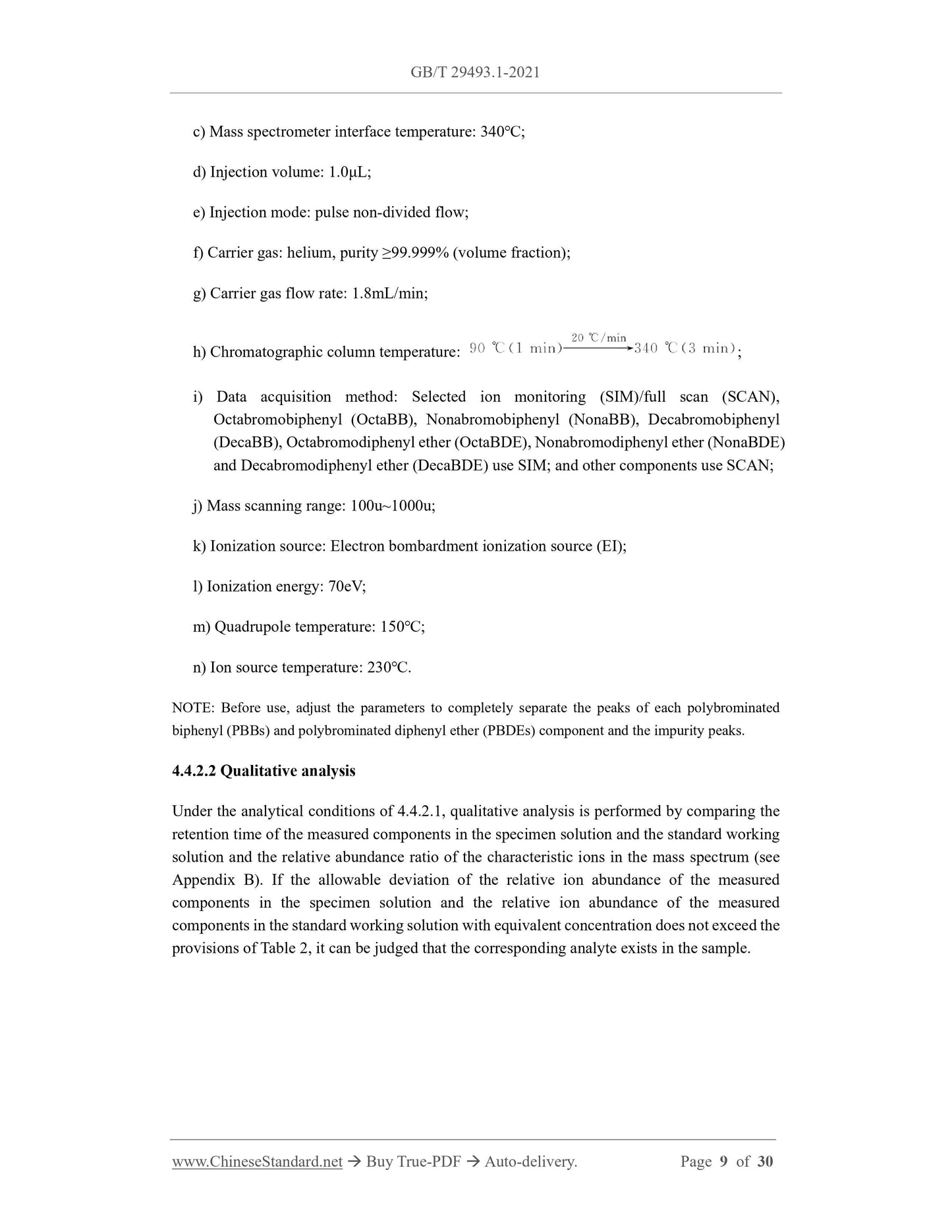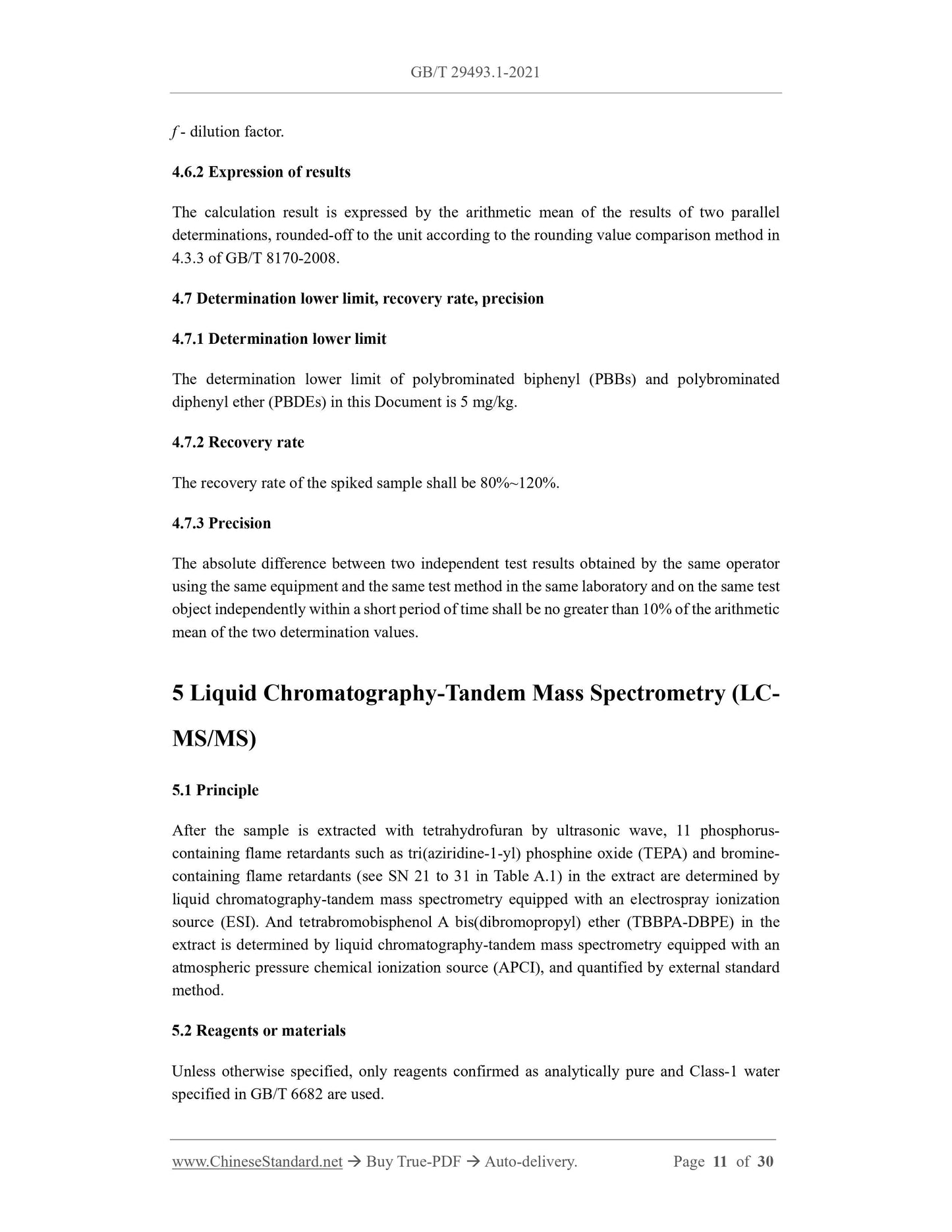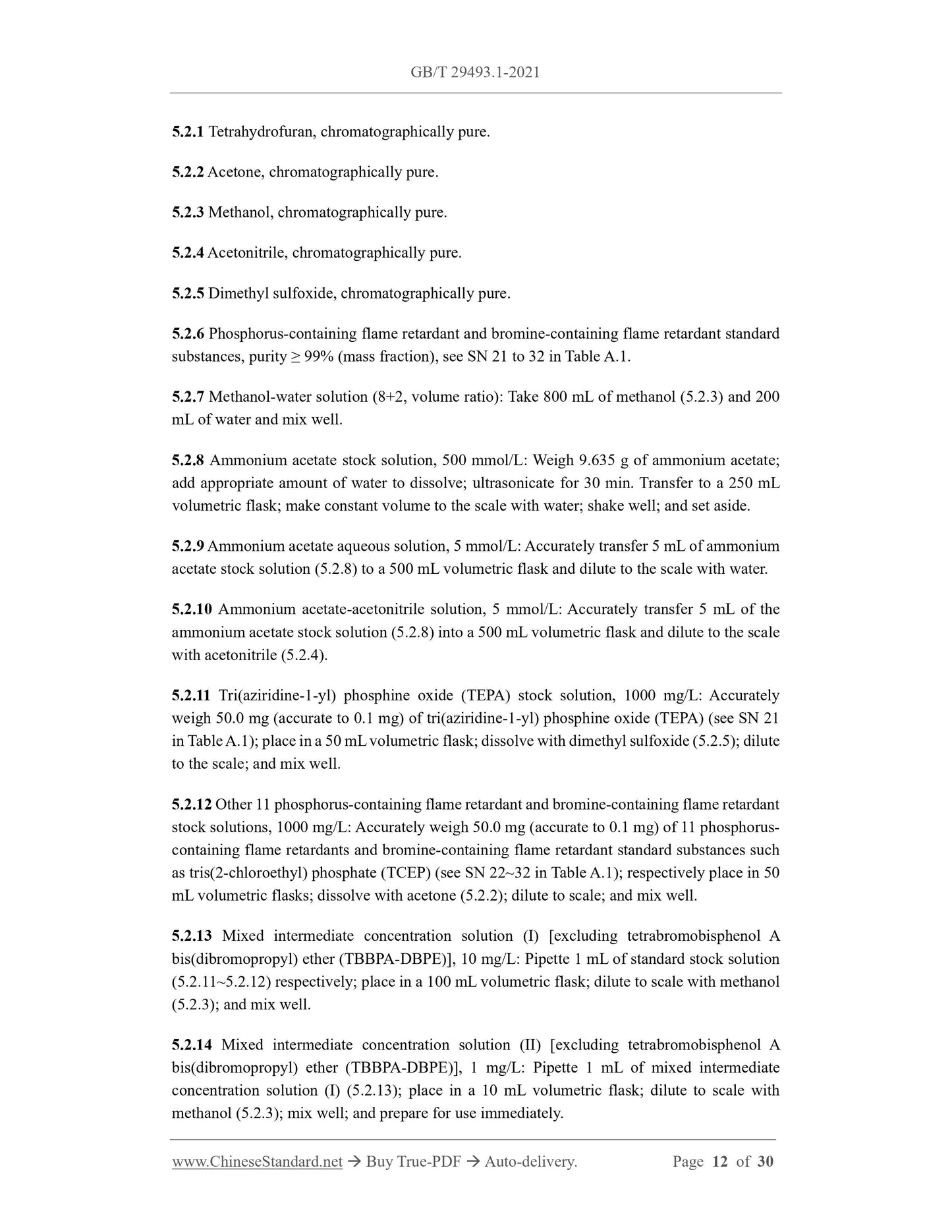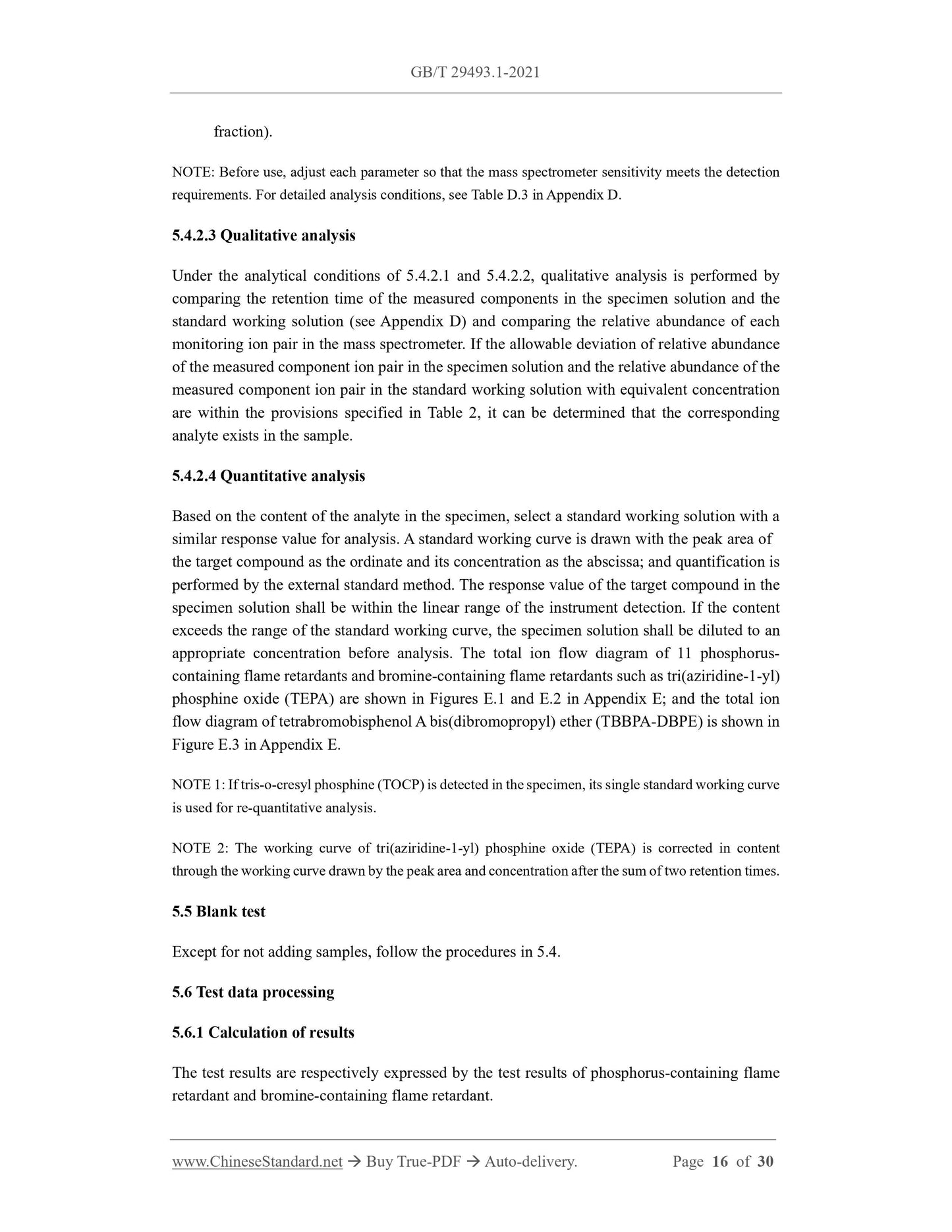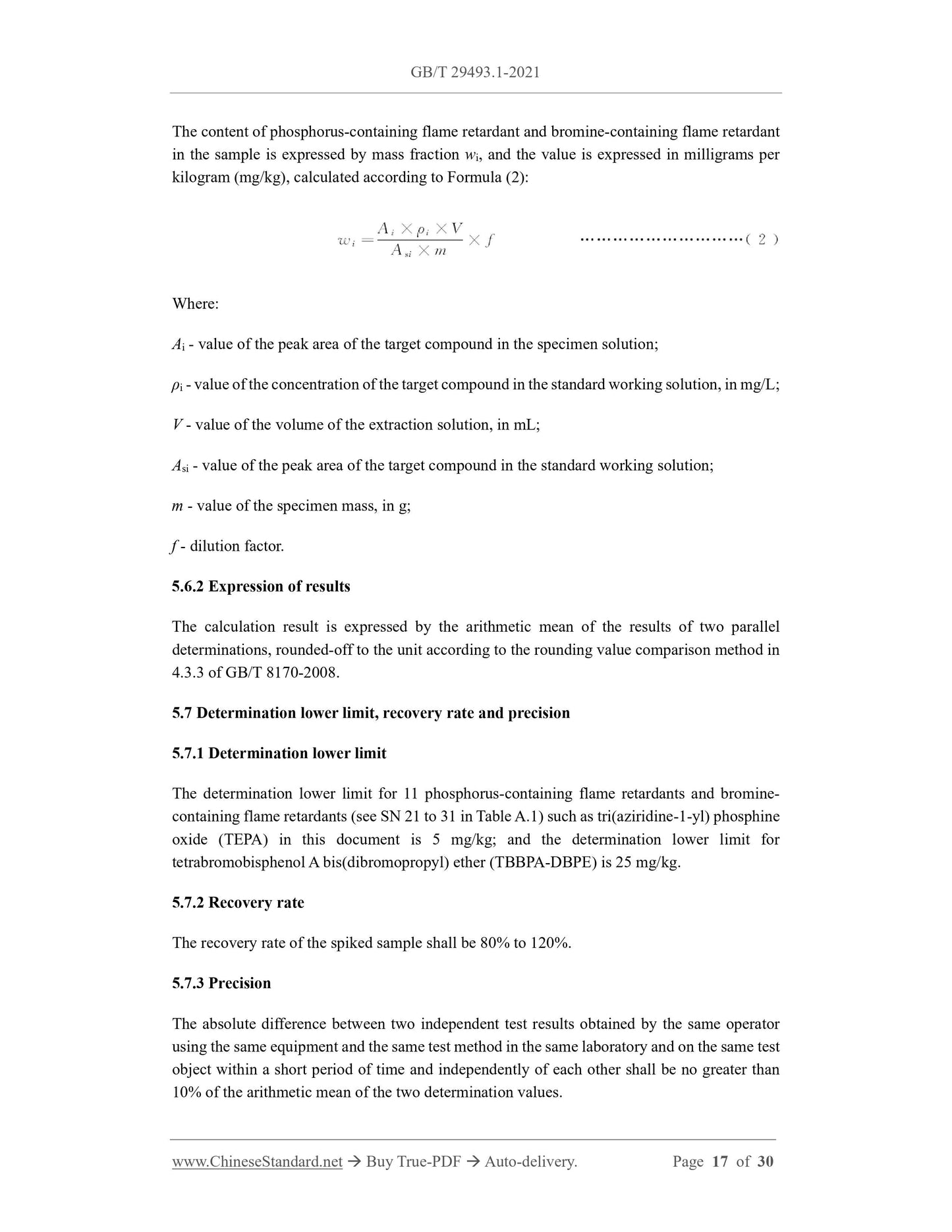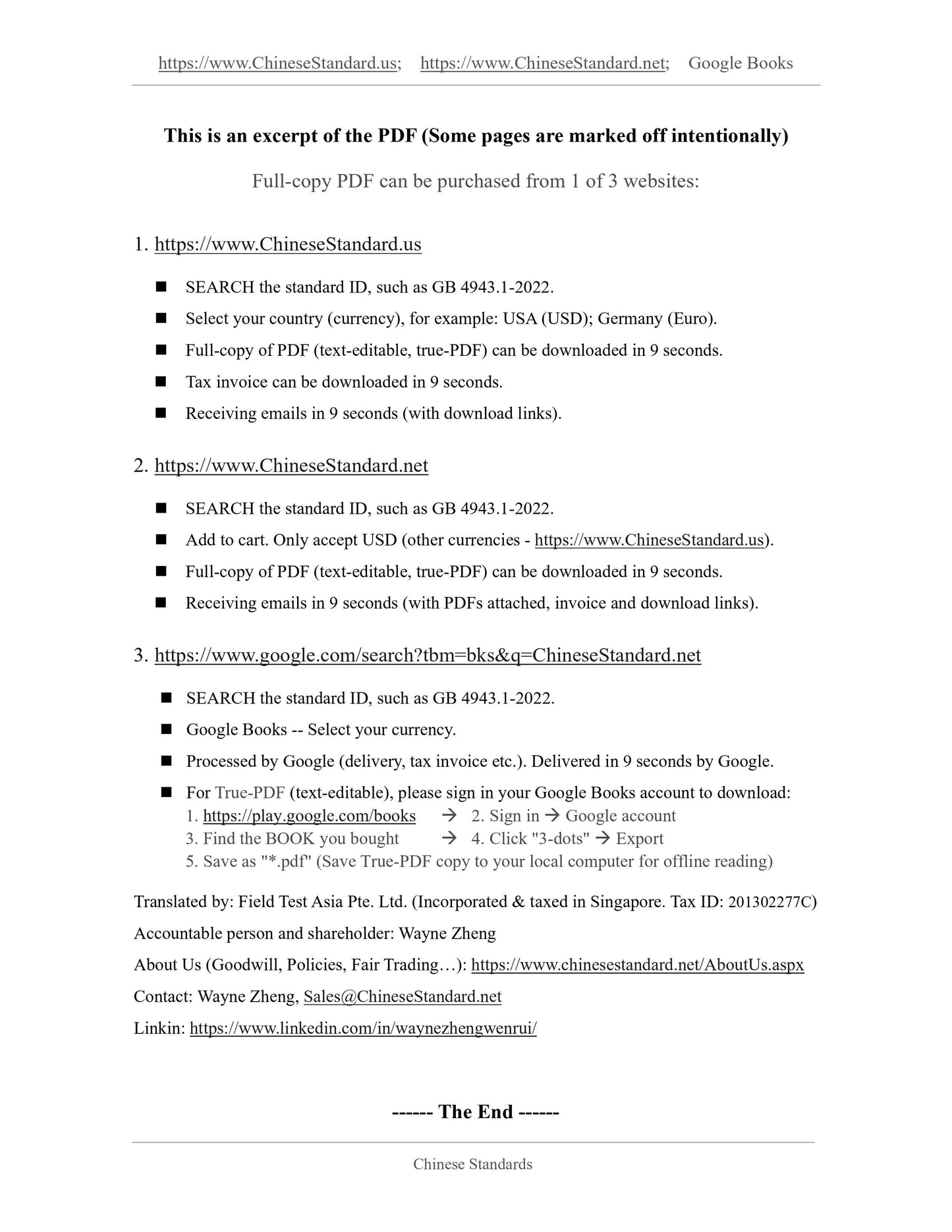1
/
of
10
www.ChineseStandard.us -- Field Test Asia Pte. Ltd.
GB/T 29493.1-2021 English PDF (GB/T29493.1-2021)
GB/T 29493.1-2021 English PDF (GB/T29493.1-2021)
Regular price
$320.00
Regular price
Sale price
$320.00
Unit price
/
per
Shipping calculated at checkout.
Couldn't load pickup availability
GB/T 29493.1-2021: Determination of harmful substances in textile dyeing and finishing auxiliaries - Part 1: Determination of the prohibited or restricted flame retardants
Delivery: 9 seconds. Download (& Email) true-PDF + Invoice.
Get Quotation: Click GB/T 29493.1-2021 (Self-service in 1-minute)
Historical versions (Master-website): GB/T 29493.1-2021
Preview True-PDF (Reload/Scroll-down if blank)
GB/T 29493.1-2021
GB
NATIONAL STANDARD OF THE
PEOPLE’S REPUBLIC OF CHINA
ICS 71.100.40
CCS G 70
Replacing GB/T 29493.1-2013
Determination of Harmful Substances in Textile Dyeing and
Finishing Auxiliaries – Part 1: Determination of the Prohibited
or Restricted Flame Retardants
ISSUED ON: OCTOBER 11, 2021
IMPLEMENTED ON: MAY 1, 2022
Issued by: State Administration for Market Regulation;
Standardization Administration of the People’s Republic of China.
Table of Contents
Foreword ... 3
Introduction ... 5
1 Scope ... 6
2 Normative References ... 6
3 Terms and Definitions ... 6
4 Gas Chromatography-Mass Spectrometry (GC-MS) ... 7
5 Liquid Chromatography-Tandem Mass Spectrometry (LC-MS/MS) ... 11
6 Test Report ... 18
Appendix A (Informative) Basic Information of Flame Retardants Tested in This
Document ... 19
Appendix B (Informative) Quantitative and Qualitative Ions of GC-MS ... 22
Appendix C (Informative) GC-MS Total Ion Flow Chromatograms of Polybrominated
Biphenyls (PBBs) and Polybrominated Diphenyl Ethers (PBDEs) ... 23
Appendix D (Informative) Mass Spectrometry Parameters of LC-MS/MS ... 26
Appendix E (Informative) LC-MS/MS Total Ion Flow Chromatograms of Phosphorus-
Containing Flame Retardants and Bromine-Containing Flame Retardants ... 28
Determination of Harmful Substances in Textile Dyeing and
Finishing Auxiliaries – Part 1: Determination of the Prohibited
or Restricted Flame Retardants
Warning: People who use this Document shall have practical experience working in
formal laboratory. This Document does not point out all possible safety issues. Users are
responsible for taking appropriate safety and health measures and ensuring that the
conditions specified in relevant national laws and regulations are met.
1 Scope
This Document specifies the method for determining the content of polybrominated biphenyls
(PBBs) and polybrominated diphenyl ethers (PBDEs) in textile dyeing and finishing auxiliaries
by gas chromatography-mass spectrometry (GC-MS); and the method for determining the
content of other prohibited and restricted phosphorus-containing flame retardants and bromine-
containing flame retardants in textile dyeing and finishing auxiliaries by liquid
chromatography-tandem mass spectrometry (LC-MS/MS).
This Document is applicable to the determination of 32 prohibited and restricted flame
retardants (see Appendix A) in textile dyeing and finishing auxiliaries.
2 Normative References
The provisions in following documents become the essential provisions of this Document
through reference in this Document. For the dated documents, only the versions with the dates
indicated are applicable to this Document; for the undated documents, only the latest version
(including all the amendments) is applicable to this Document.
GB/T 6682 Water for analytical laboratory use - Specification and test methods
GB/T 8170-2008 Rules of rounding off for numerical values and expression and judgement
of limiting values
3 Terms and Definitions
For the purposes of this Document, there are no terms and definitions apply.
4 Gas Chromatography-Mass Spectrometry (GC-MS)
4.1 Principle
After the sample is extracted with toluene by ultrasonic wave, the polybrominated biphenyls
(PBBs) and polybrominated diphenyl ethers (PBDEs) in the extract are determined by gas
chromatography-mass spectrometry and quantified by external standard method.
4.2 Reagents or materials
Unless otherwise specified, only reagents confirmed as analytically pure shall be used.
4.2.1 Anhydrous sodium sulfate.
4.2.2 Toluene: chromatographically pure.
4.2.3 Methanol: chromatographically pure.
4.2.4 Polybrominated biphenyls (PBBs) standard substances, purity ≥ 99% (mass fraction), see
SN 1 to 10 in Table A.1 of Appendix A.
4.2.5 Polybrominated diphenyl ethers (PBDEs) standard substances, purity ≥ 99% (mass
fraction), see SN 11 to 20 in Table A.1.
4.2.6 Polybrominated biphenyls (PBBs) standard stock solution, 1000 mg/L: Accurately weigh
50.0 mg (accurate to 0.1 mg) of polybrominated biphenyls (PBBs) standard substance (4.2.4);
place them in 50 mL volumetric flasks, respectively; dissolve them with toluene (4.2.2) and
dilute to the scale; and mix well.
4.2.7 Polybrominated diphenyl ether (PBDEs) standard stock solution, 1000 mg/L: Accurately
weigh 50.0 mg (accurate to 0.1 mg) of polybrominated diphenyl ether (PBDEs) standard
substance (4.2.5); place them in 50 mL volumetric flasks, respectively; dissolve them with
toluene (4.2.2) and dilute to scale; and mix well.
4.2.8 Mixed intermediate concentration solution of polybrominated biphenyls (PBBs) and
polybrominated diphenyl ethers (PBDEs), 10 mg/L: Respectively take 1 mL of polybrominated
biphenyl (PBBs) standard stock solution (4.2.6) and polybrominated diphenyl ether (PBDEs)
standard stock solution (4.2.7); place them in 100 mL volumetric flasks; dilute to scale with
toluene (4.2.2); and mix well.
4.2.9 Mixed standard working solution of polybrominated biphenyls (PBBs) and
polybrominated diphenyl ethers (PBDEs): Take an appropriate amount of the mixed
intermediate concentration solution of polybrominated biphenyls (PBBs) and polybrominated
diphenyl ethers (PBDEs) (4.2.8); dilute with toluene (4.2.2); and prepare 0.1 mg/L, 0.5 mg/L,
1 mg/L, 2 mg/L and 5 mg/L mixed standard working solutions. The preparation process is
shown in Table 1.
c) Mass spectrometer interface temperature: 340℃;
d) Injection volume: 1.0μL;
e) Injection mode: pulse non-divided flow;
f) Carrier gas: helium, purity ≥99.999% (volume fraction);
g) Carrier gas flow rate: 1.8mL/min;
h) Chromatographic column temperature: ;
i) Data acquisition method: Selected ion monitoring (SIM)/full scan (SCAN),
Octabromobiphenyl (OctaBB), Nonabromobiphenyl (NonaBB), Decabromobiphenyl
(DecaBB), Octabromodiphenyl ether (OctaBDE), Nonabromodiphenyl ether (NonaBDE)
and Decabromodiphenyl ether (DecaBDE) use SIM; and other components use SCAN;
j) Mass scanning range: 100u~1000u;
k) Ionization source: Electron bombardment ionization source (EI);
l) Ionization energy: 70eV;
m) Quadrupole temperature: 150℃;
n) Ion source temperature: 230℃.
NOTE: Before use, adjust the parameters to completely separate the peaks of each polybrominated
biphenyl (PBBs) and polybrominated diphenyl ether (PBDEs) component and the impurity peaks.
4.4.2.2 Qualitative analysis
Under the analytical conditions of 4.4.2.1, qualitative analysis is performed by comparing the
retention time of the measured components in the specimen solution and the standard working
solution and the relative abundance ratio of the characteristic ions in the mass spectrum (see
Appendix B). If the allowable deviation of the relative ion abundance of the measured
components in the specimen solution and the relative ion abundance of the measured
components in the standard working solution with equivalent concentration does not exceed the
provisions of Table 2, it can be judged that the corresponding analyte exists in the sample.
f - dilution factor.
4.6.2 Expression of results
The calculation result is expressed by the arithmetic mean of the results of two parallel
determinations, rounded-off to the unit according to the rounding value comparison method in
4.3.3 of GB/T 8170-2008.
4.7 Determination lower limit, recovery rate, precision
4.7.1 Determination lower limit
The determination lower limit of polybrominated biphenyl (PBBs) and polybrominated
diphenyl ether (PBDEs) in this Document is 5 mg/kg.
4.7.2 Recovery rate
The recovery rate of the spiked sample shall be 80%~120%.
4.7.3 Precision
The absolute difference between two independent test results obtained by the same operator
using the same equipment and the same test method in the same laboratory and on the same test
object independently within a short period of time shall be no greater than 10% of the arithmetic
mean of the two determination values.
5 Liquid Chromatography-Tandem Mass Spectrometry (LC-
MS/MS)
5.1 Principle
After the sample is extracted with tetrahydrofuran by ultrasonic wave, 11 phosphorus-
containing flame retardants such as tri(aziridine-1-yl) phosphine oxide (TEPA) and bromine-
containing flame retardants (see SN 21 to 31 in Table A.1) in the extract are determined by
liquid chromatography-tandem mass spectrometry equipped with an electrospray ionization
source (ESI). And tetrabromobisphenol A bis(dibromopropyl) ether (TBBPA-DBPE) in the
extract is determined by liquid chromatography-tandem mass spectrometry equipped with an
atmospheric pressure chemical ionization source (APCI), and quantified by external standard
method.
5.2 Reagents or materials
Unless otherwise specified, only reagents confirmed as analytically pure and Class-1 water
specified in GB/T 6682 are used.
5.2.1 Tetrahydrofuran, chromatographically pure.
5.2.2 Acetone, chromatographically pure.
5.2.3 Methanol, chromatographically pure.
5.2.4 Acetonitrile, chromatographically pure.
5.2.5 Dimethyl sulfoxide, chromatographically pure.
5.2.6 Phosphorus-containing flame retardant and bromine-containing flame retardant standard
substances, purity ≥ 99% (mass fraction), see SN 21 to 32 in Table A.1.
5.2.7 Methanol-water solution (8+2, volume ratio): Take 800 mL of methanol (5.2.3) and 200
mL of water and mix well.
5.2.8 Ammonium acetate stock solution, 500 mmol/L: Weigh 9.635 g of ammonium acetate;
add appropriate amount of water to dissolve; ultrasonicate for 30 min. Transfer to a 250 mL
volumetric flask; make constant volume to the scale with water; shake well; and set aside.
5.2.9 Ammonium acetate aqueous solution, 5 mmol/L: Accurately transfer 5 mL of ammonium
acetate stock solution (5.2.8) to a 500 mL volumetric flask and dilute to the scale with water.
5.2.10 Ammonium acetate-acetonitrile solution, 5 mmol/L: Accurately transfer 5 mL of the
ammonium acetate stock solution (5.2.8) into a 500 mL volumetric flask and dilute to the scale
with acetonitrile (5.2.4).
5.2.11 Tri(aziridine-1-yl) phosphine oxide (TEPA) stock solution, 1000 mg/L: Accurately
weigh 50.0 mg (accurate to 0.1 mg) of tri(aziridine-1-yl) phosphine oxide (TEPA) (see SN 21
in Table A.1); place in a 50 mL volumetric flask; dissolve with dimethyl sulfoxide (5.2.5); dilute
to the scale; and mix well.
5.2.12 Other 11 phosphorus-containing flame retardant and bromine-containing flame retardant
stock solutions, 1000 mg/L: Accurately weigh 50.0 mg (accurate to 0.1 mg) of 11 phosphorus-
containing flame retardants and bromine-containing flame retardant standard substances such
as tris(2-chloroethyl) phosphate (TCEP) (see SN 22~32 in Table A.1); respectively place in 50
mL volumetric flasks; dissolve with acetone (5.2.2); dilute to scale; and mix well.
5.2.13 Mixed intermediate concentration solution (I) [excluding tetrabromobisphenol A
bis(dibromopropyl) ether (TBBPA-DBPE)], 10 mg/L: Pipette 1 mL of standard stock solution
(5.2.11~5.2.12) respectively; place in a 100 mL volumetric flask; dilute to scale with methanol
(5.2.3); and mix well.
5.2.14 Mixed intermediate concentration solution (II) [excluding tetrabromobisphenol A
bis(dibromopropyl) ether (TBBPA-DBPE)], 1 mg/L: Pipette 1 mL of mixed intermediate
concentration solution (I) (5.2.13); place in a 10 mL volumetric flask; dilute to scale with
methanol (5.2.3); mix well; and prepare for use immediately.
fraction).
NOTE: Before use, adjust each parameter so that the mass spectrometer sensitivity meets the detection
requirements. For detailed analysis conditions, see Table D.3 in Appendix D.
5.4.2.3 Qualitative analysis
Under the analytical conditions of 5.4.2.1 and 5.4.2.2, qualitative analysis is performed by
comparing the retention time of the measured components in the specimen solution and the
standard working solution (see Appendix D) and comparing the relative abundance of each
monitoring ion pair in the mass spectrometer. If the allowable deviation of relative abundance
of the measured component ion pair in the specimen solution and the relative abundance of the
measured component ion pair in the standard working solution with equivalent concentration
are within the provisions specified in Table 2, it can be determined that the corresponding
analyte exists in the sample.
5.4.2.4 Quantitative analysis
Based on the content of the analyte in the specimen, select a standard working solution with a
similar response value for analysis. A standard working curve is drawn with the peak area of
the target compound as the ordinate and its concentration as the abscissa; and quantification is
performed by the external standard method. The response value of the target compound in the
specimen solution shall be within the linear range of the instrument detection. If the content
exceeds the range of the standard working curve, the specimen solution shall be diluted to an
appropriate concentration before analysis. The total ion flow diagram of 11 phosphorus-
containing flame retardants and bromine-containing flame retardants such as tri(aziridine-1-yl)
phosphine oxide (TEPA) are shown in Figures E.1 and E.2 in Appendix E; and the total ion
flow diagram of tetrabromobisphenol A bis(dibromopropyl) ether (TBBPA-DBPE) is shown in
Figure E.3 in Appendix E.
NOTE 1: If tris-o-cresyl phosphine (TOCP) is detected in the specimen, its single standard working curve
is used for re-quantitative analysis.
NOTE 2: The working curve of tri(aziridine-1-yl) phosphine oxide (TEPA) is corrected in content
through the working curve drawn by the peak area and concentration after the sum of two retention times.
5.5 Blank test
Except for not adding samples, follow the procedures in 5.4.
5.6 Test data processing
5.6.1 Calculation of results
The test results are respectively expressed by the test results of phosphorus-containing flame
retardant and bromine-containing flame retardant.
The content of phosphorus-containing flame retardant and bromine-containing flame retardant
in the sample is expressed by mass fraction wi, and the value is expressed in milligrams per
ki...
Delivery: 9 seconds. Download (& Email) true-PDF + Invoice.
Get Quotation: Click GB/T 29493.1-2021 (Self-service in 1-minute)
Historical versions (Master-website): GB/T 29493.1-2021
Preview True-PDF (Reload/Scroll-down if blank)
GB/T 29493.1-2021
GB
NATIONAL STANDARD OF THE
PEOPLE’S REPUBLIC OF CHINA
ICS 71.100.40
CCS G 70
Replacing GB/T 29493.1-2013
Determination of Harmful Substances in Textile Dyeing and
Finishing Auxiliaries – Part 1: Determination of the Prohibited
or Restricted Flame Retardants
ISSUED ON: OCTOBER 11, 2021
IMPLEMENTED ON: MAY 1, 2022
Issued by: State Administration for Market Regulation;
Standardization Administration of the People’s Republic of China.
Table of Contents
Foreword ... 3
Introduction ... 5
1 Scope ... 6
2 Normative References ... 6
3 Terms and Definitions ... 6
4 Gas Chromatography-Mass Spectrometry (GC-MS) ... 7
5 Liquid Chromatography-Tandem Mass Spectrometry (LC-MS/MS) ... 11
6 Test Report ... 18
Appendix A (Informative) Basic Information of Flame Retardants Tested in This
Document ... 19
Appendix B (Informative) Quantitative and Qualitative Ions of GC-MS ... 22
Appendix C (Informative) GC-MS Total Ion Flow Chromatograms of Polybrominated
Biphenyls (PBBs) and Polybrominated Diphenyl Ethers (PBDEs) ... 23
Appendix D (Informative) Mass Spectrometry Parameters of LC-MS/MS ... 26
Appendix E (Informative) LC-MS/MS Total Ion Flow Chromatograms of Phosphorus-
Containing Flame Retardants and Bromine-Containing Flame Retardants ... 28
Determination of Harmful Substances in Textile Dyeing and
Finishing Auxiliaries – Part 1: Determination of the Prohibited
or Restricted Flame Retardants
Warning: People who use this Document shall have practical experience working in
formal laboratory. This Document does not point out all possible safety issues. Users are
responsible for taking appropriate safety and health measures and ensuring that the
conditions specified in relevant national laws and regulations are met.
1 Scope
This Document specifies the method for determining the content of polybrominated biphenyls
(PBBs) and polybrominated diphenyl ethers (PBDEs) in textile dyeing and finishing auxiliaries
by gas chromatography-mass spectrometry (GC-MS); and the method for determining the
content of other prohibited and restricted phosphorus-containing flame retardants and bromine-
containing flame retardants in textile dyeing and finishing auxiliaries by liquid
chromatography-tandem mass spectrometry (LC-MS/MS).
This Document is applicable to the determination of 32 prohibited and restricted flame
retardants (see Appendix A) in textile dyeing and finishing auxiliaries.
2 Normative References
The provisions in following documents become the essential provisions of this Document
through reference in this Document. For the dated documents, only the versions with the dates
indicated are applicable to this Document; for the undated documents, only the latest version
(including all the amendments) is applicable to this Document.
GB/T 6682 Water for analytical laboratory use - Specification and test methods
GB/T 8170-2008 Rules of rounding off for numerical values and expression and judgement
of limiting values
3 Terms and Definitions
For the purposes of this Document, there are no terms and definitions apply.
4 Gas Chromatography-Mass Spectrometry (GC-MS)
4.1 Principle
After the sample is extracted with toluene by ultrasonic wave, the polybrominated biphenyls
(PBBs) and polybrominated diphenyl ethers (PBDEs) in the extract are determined by gas
chromatography-mass spectrometry and quantified by external standard method.
4.2 Reagents or materials
Unless otherwise specified, only reagents confirmed as analytically pure shall be used.
4.2.1 Anhydrous sodium sulfate.
4.2.2 Toluene: chromatographically pure.
4.2.3 Methanol: chromatographically pure.
4.2.4 Polybrominated biphenyls (PBBs) standard substances, purity ≥ 99% (mass fraction), see
SN 1 to 10 in Table A.1 of Appendix A.
4.2.5 Polybrominated diphenyl ethers (PBDEs) standard substances, purity ≥ 99% (mass
fraction), see SN 11 to 20 in Table A.1.
4.2.6 Polybrominated biphenyls (PBBs) standard stock solution, 1000 mg/L: Accurately weigh
50.0 mg (accurate to 0.1 mg) of polybrominated biphenyls (PBBs) standard substance (4.2.4);
place them in 50 mL volumetric flasks, respectively; dissolve them with toluene (4.2.2) and
dilute to the scale; and mix well.
4.2.7 Polybrominated diphenyl ether (PBDEs) standard stock solution, 1000 mg/L: Accurately
weigh 50.0 mg (accurate to 0.1 mg) of polybrominated diphenyl ether (PBDEs) standard
substance (4.2.5); place them in 50 mL volumetric flasks, respectively; dissolve them with
toluene (4.2.2) and dilute to scale; and mix well.
4.2.8 Mixed intermediate concentration solution of polybrominated biphenyls (PBBs) and
polybrominated diphenyl ethers (PBDEs), 10 mg/L: Respectively take 1 mL of polybrominated
biphenyl (PBBs) standard stock solution (4.2.6) and polybrominated diphenyl ether (PBDEs)
standard stock solution (4.2.7); place them in 100 mL volumetric flasks; dilute to scale with
toluene (4.2.2); and mix well.
4.2.9 Mixed standard working solution of polybrominated biphenyls (PBBs) and
polybrominated diphenyl ethers (PBDEs): Take an appropriate amount of the mixed
intermediate concentration solution of polybrominated biphenyls (PBBs) and polybrominated
diphenyl ethers (PBDEs) (4.2.8); dilute with toluene (4.2.2); and prepare 0.1 mg/L, 0.5 mg/L,
1 mg/L, 2 mg/L and 5 mg/L mixed standard working solutions. The preparation process is
shown in Table 1.
c) Mass spectrometer interface temperature: 340℃;
d) Injection volume: 1.0μL;
e) Injection mode: pulse non-divided flow;
f) Carrier gas: helium, purity ≥99.999% (volume fraction);
g) Carrier gas flow rate: 1.8mL/min;
h) Chromatographic column temperature: ;
i) Data acquisition method: Selected ion monitoring (SIM)/full scan (SCAN),
Octabromobiphenyl (OctaBB), Nonabromobiphenyl (NonaBB), Decabromobiphenyl
(DecaBB), Octabromodiphenyl ether (OctaBDE), Nonabromodiphenyl ether (NonaBDE)
and Decabromodiphenyl ether (DecaBDE) use SIM; and other components use SCAN;
j) Mass scanning range: 100u~1000u;
k) Ionization source: Electron bombardment ionization source (EI);
l) Ionization energy: 70eV;
m) Quadrupole temperature: 150℃;
n) Ion source temperature: 230℃.
NOTE: Before use, adjust the parameters to completely separate the peaks of each polybrominated
biphenyl (PBBs) and polybrominated diphenyl ether (PBDEs) component and the impurity peaks.
4.4.2.2 Qualitative analysis
Under the analytical conditions of 4.4.2.1, qualitative analysis is performed by comparing the
retention time of the measured components in the specimen solution and the standard working
solution and the relative abundance ratio of the characteristic ions in the mass spectrum (see
Appendix B). If the allowable deviation of the relative ion abundance of the measured
components in the specimen solution and the relative ion abundance of the measured
components in the standard working solution with equivalent concentration does not exceed the
provisions of Table 2, it can be judged that the corresponding analyte exists in the sample.
f - dilution factor.
4.6.2 Expression of results
The calculation result is expressed by the arithmetic mean of the results of two parallel
determinations, rounded-off to the unit according to the rounding value comparison method in
4.3.3 of GB/T 8170-2008.
4.7 Determination lower limit, recovery rate, precision
4.7.1 Determination lower limit
The determination lower limit of polybrominated biphenyl (PBBs) and polybrominated
diphenyl ether (PBDEs) in this Document is 5 mg/kg.
4.7.2 Recovery rate
The recovery rate of the spiked sample shall be 80%~120%.
4.7.3 Precision
The absolute difference between two independent test results obtained by the same operator
using the same equipment and the same test method in the same laboratory and on the same test
object independently within a short period of time shall be no greater than 10% of the arithmetic
mean of the two determination values.
5 Liquid Chromatography-Tandem Mass Spectrometry (LC-
MS/MS)
5.1 Principle
After the sample is extracted with tetrahydrofuran by ultrasonic wave, 11 phosphorus-
containing flame retardants such as tri(aziridine-1-yl) phosphine oxide (TEPA) and bromine-
containing flame retardants (see SN 21 to 31 in Table A.1) in the extract are determined by
liquid chromatography-tandem mass spectrometry equipped with an electrospray ionization
source (ESI). And tetrabromobisphenol A bis(dibromopropyl) ether (TBBPA-DBPE) in the
extract is determined by liquid chromatography-tandem mass spectrometry equipped with an
atmospheric pressure chemical ionization source (APCI), and quantified by external standard
method.
5.2 Reagents or materials
Unless otherwise specified, only reagents confirmed as analytically pure and Class-1 water
specified in GB/T 6682 are used.
5.2.1 Tetrahydrofuran, chromatographically pure.
5.2.2 Acetone, chromatographically pure.
5.2.3 Methanol, chromatographically pure.
5.2.4 Acetonitrile, chromatographically pure.
5.2.5 Dimethyl sulfoxide, chromatographically pure.
5.2.6 Phosphorus-containing flame retardant and bromine-containing flame retardant standard
substances, purity ≥ 99% (mass fraction), see SN 21 to 32 in Table A.1.
5.2.7 Methanol-water solution (8+2, volume ratio): Take 800 mL of methanol (5.2.3) and 200
mL of water and mix well.
5.2.8 Ammonium acetate stock solution, 500 mmol/L: Weigh 9.635 g of ammonium acetate;
add appropriate amount of water to dissolve; ultrasonicate for 30 min. Transfer to a 250 mL
volumetric flask; make constant volume to the scale with water; shake well; and set aside.
5.2.9 Ammonium acetate aqueous solution, 5 mmol/L: Accurately transfer 5 mL of ammonium
acetate stock solution (5.2.8) to a 500 mL volumetric flask and dilute to the scale with water.
5.2.10 Ammonium acetate-acetonitrile solution, 5 mmol/L: Accurately transfer 5 mL of the
ammonium acetate stock solution (5.2.8) into a 500 mL volumetric flask and dilute to the scale
with acetonitrile (5.2.4).
5.2.11 Tri(aziridine-1-yl) phosphine oxide (TEPA) stock solution, 1000 mg/L: Accurately
weigh 50.0 mg (accurate to 0.1 mg) of tri(aziridine-1-yl) phosphine oxide (TEPA) (see SN 21
in Table A.1); place in a 50 mL volumetric flask; dissolve with dimethyl sulfoxide (5.2.5); dilute
to the scale; and mix well.
5.2.12 Other 11 phosphorus-containing flame retardant and bromine-containing flame retardant
stock solutions, 1000 mg/L: Accurately weigh 50.0 mg (accurate to 0.1 mg) of 11 phosphorus-
containing flame retardants and bromine-containing flame retardant standard substances such
as tris(2-chloroethyl) phosphate (TCEP) (see SN 22~32 in Table A.1); respectively place in 50
mL volumetric flasks; dissolve with acetone (5.2.2); dilute to scale; and mix well.
5.2.13 Mixed intermediate concentration solution (I) [excluding tetrabromobisphenol A
bis(dibromopropyl) ether (TBBPA-DBPE)], 10 mg/L: Pipette 1 mL of standard stock solution
(5.2.11~5.2.12) respectively; place in a 100 mL volumetric flask; dilute to scale with methanol
(5.2.3); and mix well.
5.2.14 Mixed intermediate concentration solution (II) [excluding tetrabromobisphenol A
bis(dibromopropyl) ether (TBBPA-DBPE)], 1 mg/L: Pipette 1 mL of mixed intermediate
concentration solution (I) (5.2.13); place in a 10 mL volumetric flask; dilute to scale with
methanol (5.2.3); mix well; and prepare for use immediately.
fraction).
NOTE: Before use, adjust each parameter so that the mass spectrometer sensitivity meets the detection
requirements. For detailed analysis conditions, see Table D.3 in Appendix D.
5.4.2.3 Qualitative analysis
Under the analytical conditions of 5.4.2.1 and 5.4.2.2, qualitative analysis is performed by
comparing the retention time of the measured components in the specimen solution and the
standard working solution (see Appendix D) and comparing the relative abundance of each
monitoring ion pair in the mass spectrometer. If the allowable deviation of relative abundance
of the measured component ion pair in the specimen solution and the relative abundance of the
measured component ion pair in the standard working solution with equivalent concentration
are within the provisions specified in Table 2, it can be determined that the corresponding
analyte exists in the sample.
5.4.2.4 Quantitative analysis
Based on the content of the analyte in the specimen, select a standard working solution with a
similar response value for analysis. A standard working curve is drawn with the peak area of
the target compound as the ordinate and its concentration as the abscissa; and quantification is
performed by the external standard method. The response value of the target compound in the
specimen solution shall be within the linear range of the instrument detection. If the content
exceeds the range of the standard working curve, the specimen solution shall be diluted to an
appropriate concentration before analysis. The total ion flow diagram of 11 phosphorus-
containing flame retardants and bromine-containing flame retardants such as tri(aziridine-1-yl)
phosphine oxide (TEPA) are shown in Figures E.1 and E.2 in Appendix E; and the total ion
flow diagram of tetrabromobisphenol A bis(dibromopropyl) ether (TBBPA-DBPE) is shown in
Figure E.3 in Appendix E.
NOTE 1: If tris-o-cresyl phosphine (TOCP) is detected in the specimen, its single standard working curve
is used for re-quantitative analysis.
NOTE 2: The working curve of tri(aziridine-1-yl) phosphine oxide (TEPA) is corrected in content
through the working curve drawn by the peak area and concentration after the sum of two retention times.
5.5 Blank test
Except for not adding samples, follow the procedures in 5.4.
5.6 Test data processing
5.6.1 Calculation of results
The test results are respectively expressed by the test results of phosphorus-containing flame
retardant and bromine-containing flame retardant.
The content of phosphorus-containing flame retardant and bromine-containing flame retardant
in the sample is expressed by mass fraction wi, and the value is expressed in milligrams per
ki...
Share
